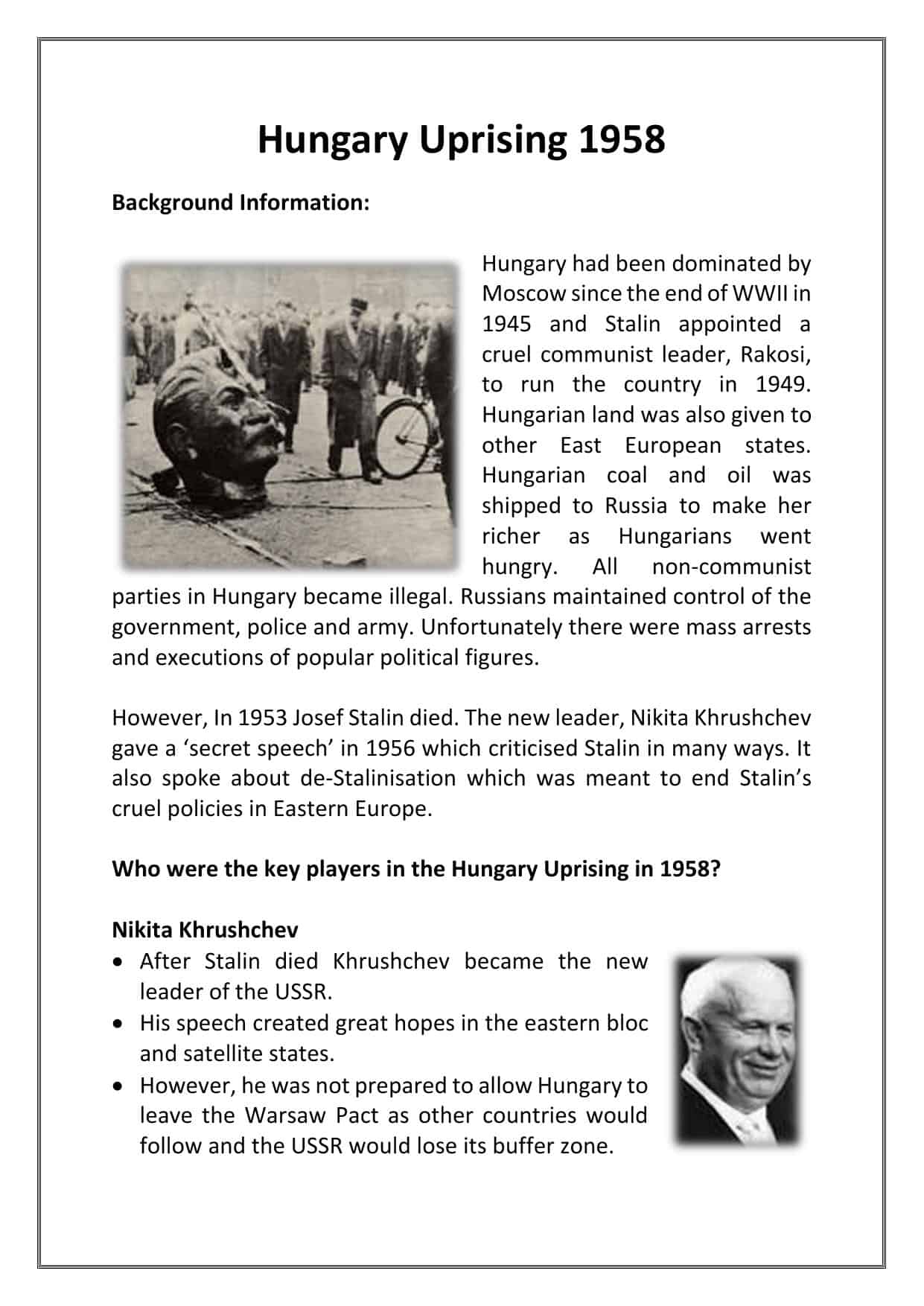Download Hungary Uprising 1958 Facts & Worksheet
Click the button below to download this worksheet for use in the classroom or at home.
Download →
Facts & Information Worksheet
Hungary had been dominated by Moscow since the end of WWII in 1945 and Stalin appointed a cruel communist leader, Rakosi, to run the country in 1949. Hungarian land was also given to other East European states. Hungarian coal and oil was shipped to Russia to make her richer as Hungarians went hungry. All non-communist
parties in Hungary became illegal. Russians maintained control of the government, police and army. Unfortunately there were mass arrests and executions of popular political figures.
However, In 1953 Josef Stalin died. The new leader, Nikita Khrushchev gave a ‘secret speech’ in 1956 which criticised Stalin in many ways. It also spoke about de-Stalinisation which was meant to end Stalin’s cruel policies in Eastern Europe.
Who were the key players in the Hungary Uprising in 1958?
Nikita Khrushchev
- After Stalin died Khrushchev became the new leader of the USSR.
- His speech created great hopes in the eastern bloc and satellite states.
- However, he was not prepared to allow Hungary to leave the Warsaw Pact as other countries would follow and the USSR would lose its buffer zone.
Matyas Rakosi
- Rakosi was Hungarian dictator appointed as leader by Stalin in post war Hungary.
- He behaved like a ‘little Stalin’ and described himself as ‘Stalin’s best pupil’.
- He was despised by many for his tyrannical ways, some 387,000 intellectuals were imprisoned and 2,000 killed from 1948-56.Imre Nagy
- Nagy, very much like Rakosi, was a Hungarian communist.
- However, he worked for the government as the Minister of Agriculture in 1945.
- However, he became a reformer in Hungary and was soon the people’s favourite, a symbol of moderation and a new beginning.
- However, after gaining Khrushchev’s trust he defied the Soviet leadership.Janos Kadar
- Janos Kadar created a new government, loyal to Khrushchev and Russia during the uprising.
- He helped to re-establish communist control in Hungary, and used Hungarian troops to assist Soviet forces in restoring order.
Uprising Details:
-
-
- 1. After bad harvests, fuel and bread shortages there were protests in the capital of Hungary – Budapest.
-
-
-
- 2. Students paraded on the streets and demanded free speech, the end of the secret police, and the withdrawal of soviet troops.
-
-
-
- 3. The students carried Hungarian flags with the soviet emblem removed and demanded that Imre Nagy secure independence from Russia.
-
-
-
- 4. Stalin’s statue was smashed and there was fierce fighting between armed Hungarians and soviet troops on the streets of Budapest.
-
-
-
- 5. After four days of heavy losses on both sides Nagy arranged a ceasefire.
-
-
-
- 6. Moscow agreed to withdraw soviet troops if Nagy, now leader of the Hungarian Party, returned stability to the streets and restored communist authority.
-
-
-
- 7. The Hungarian leadership began to question Soviet control in April 1956 which led to demonstrations peaking in late October 1956 and the Russian army invaded on 4th November 1956.
-
Tasks:
What were the events leading up to the Hungarian Uprising?
Who were the key players in the Hungarian Uprising?
Describe the key events of the Hungarian Uprising?
What are the key dates of the Hungarian Uprising?
What were the consequences of the Hungarian Uprising?
GCSE Study Material:
-
- Aimed at Students studying at UK GCSE or equivalent
- Premium members only
- Hungary Uprising 1958 Facts & Worksheets.
- Utilise with other Cold war worksheets & resources.
